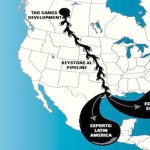
New research from the Carbon Tracker Initiative reveals approval of the controversial Keystone XL pipeline would only have a marginal positive impact of the economics of the Canadian oil-sands industry, but could trigger a rush of investment into additional risky high-cost, high-carbon projects, dependent on rising oil prices.

The report, Keystone XL Pipeline: A Potential Mirage for Oil-sands Investors, shows “new Canadian oil-sands development is increasingly economically questionable without the additional export capacity that pipelines such as Keystone XL would bring,” says Mark Lewis, external research advisor to Carbon Tracker. “But the vision of improved prices it promises could quickly be wiped out by increasing costs, meaning investors who believed the mirage of improved oil-sands economics with KXL will be left disappointed.”
“Efforts to stay within a carbon budget, increase fuel efficiency, reduce costs and improve air quality mean that if capital continues to flow into oil sands, the projects risk becoming stranded assets,” says Carbon Tracker’s research director, James Leaton.
Questionable Project Economics
Oil sands in situ projects currently under consideration need above $65/barrel net-present value to break-even according to Rystad Energy. Given the discounted price Western Canada Select output achieves, these projects will not produce a profit.
Keystone XL will enable oil sands production to achieve higher prices—perhaps equivalent to the current Maya (Mexican heavy crude) price or WTI price achieved on the U.S. Gulf Coast, generating a $20/barrel price uplift.
However, it is not clear that the margin will improve given the cost increases that will accompany the uplift in price. Production with Keystone XL will incur greater pipeline transit and diluent costs reducing this uplift to around $5.5/barrel. This leaves only a few dollars margin to absorb other factors such as potential carbon offset costs, likely inflation in labor, materials and energy costs.
This makes it questionable that the margins will improve sufficiently to make even the lowest cost $65/barrel projects provide sufficient returns for investors. Investment in heavy oil refining capacity will also need to be factored in if production increases.
The economics of rail are no more promising than Keystone XL. It is not clear that sufficient commitments are in place to utilise new capacity at the current cost levels. The volumes that could be brought on stream are also not likely to be equivalent to the time and scale of a pipeline such as Keystone XL.

Carbon Pollution
Keystone XL and rail are additional export routes to the current limited infrastructure. The export capacity is the limiting factor to production—which the industry body figures show could utilize all mooted pipeline routes and increased rail capacity. Keystone XL would mean more production sooner, which is evidenced by analysts giving oil sands producers higher valuations with Keystone XL.
However, as co-advisor Mark Fulton says, “KXL will improve revenues in the short-term which means that it will help catalyse new investment, more oil-sands production and additional greenhouse gas emissions.”
This is confirmed by the Canadian government offering to offset these emissions, which further undermine Keystone XL’s economic benefit.
Access to More Capital
Keystone XL-enabled production will mean more revenues for oil sands producers, which will improve the market’s view of the value and creditworthiness of the companies. This will help them access capital, or reduce its cost, which will facilitate further investment in the oil sands, leading to more production and therefore more emissions. However, this in turn will put upward pressure on costs in Alberta, and soon exhaust the additional transportation capacity the pipeline would provide, further depressing prices.
Conclusion
Keystone XL constitutes a mirage that may tempt investment in greater production in search of higher margins, which are not likely to materialize without continued upward movement in oil prices. Keystone XL could provide some temporary relief to oil sands export constraints, which will stimulate the cycle of investment again, which either will lead to increased emissions or stranded assets in the future.
The analysis follows Carbon Tracker’s recent collaboration with CERES to co-ordinate a group of large investors to engage with companies on stress-testing their capital expenditure plans against a range of price and emissions scenarios. With the context of these considerations, Leaton notes that, “oil sands are high-cost, high-carbon projects, being proposed at a time when both costs and emissions are under pressure to shrink; as such they should immediately hit an investor’s higher-risk screen.”
Visit EcoWatch’s KEYSTONE XL and TAR SANDS pages for more related news on this topic.


Leave a Reply
You must be logged in to post a comment.